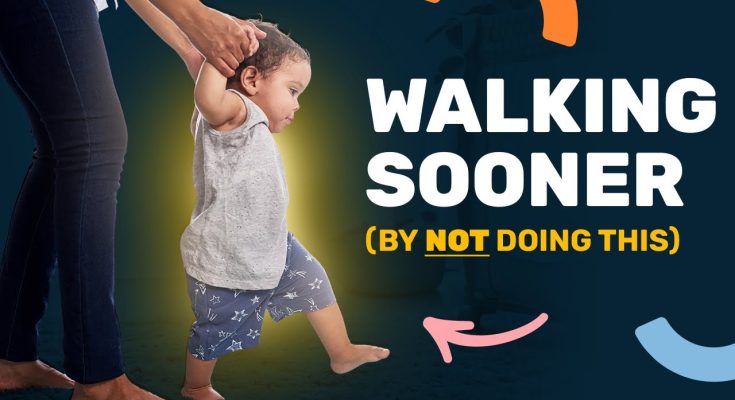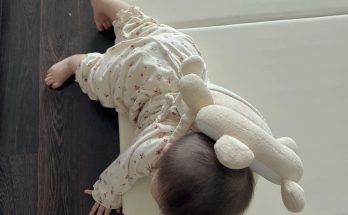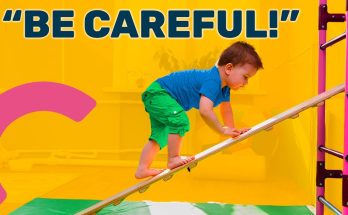Every parent eagerly anticipates their child’s first steps, marking a significant milestone in their development. While some babies begin walking as early as 9 months, others may take until 15 or 16 months to get moving. Parents often think that the best way to encourage walking is by using walkers, holding their baby’s hands, or guiding them step by step. However, some of the most effective strategies to help your child walk sooner are counterintuitive—going against common advice.
If you’re looking to speed up your child’s walking journey, here are some surprising but effective strategies that may help.
1. Stop Holding Their Hands While Walking
Why It Feels Right:
Many parents instinctively hold their baby’s hands and guide them forward, believing this will help them practice walking. It seems logical—if they can walk with assistance, surely they will soon walk on their own, right?
Why It’s Counterintuitive but Effective:
Holding your baby’s hands too often can actually delay independent walking. When a baby relies on their hands being held, they develop an unnatural gait and don’t learn to balance on their own. Instead of holding their hands, encourage them to cruise along furniture or push a sturdy object, which allows them to practice balance and weight shifting without excessive support.
What to Do Instead:
- Let them cruise along furniture instead of leading them by hand.
- Encourage them to push a weighted toy or a laundry basket for support.
- Offer your hand for occasional reassurance, but let go quickly.
2. Let Them Walk Barefoot
Why It Feels Right:
Many parents think that baby shoes provide necessary support for walking. In fact, the baby shoe industry thrives on the belief that infants need structured footwear to develop proper walking habits.
Why It’s Counterintuitive but Effective:
Walking barefoot allows babies to feel the ground, improving their sense of balance and coordination. Their toes naturally grip surfaces, helping them develop strength in their feet and ankles. Shoes, especially those with thick soles, limit foot mobility and make balance harder.
What to Do Instead:
- Let your baby go barefoot as much as possible, especially indoors.
- If shoes are necessary (for outdoors), choose soft, flexible, and lightweight ones.
- Encourage walking on different textures (carpet, grass, tile) to improve sensory feedback.
3. Resist the Urge to Use a Baby Walker
Why It Feels Right:
Walkers seem like the perfect solution to help a baby move independently. They provide mobility before the child can walk on their own, leading parents to believe they encourage early walking.
Why It’s Counterintuitive but Effective:
Research shows that baby walkers can actually delay independent walking. They allow babies to “walk” without learning essential skills like balancing, weight shifting, and coordinating their legs naturally. Walkers encourage tiptoeing and prevent babies from developing the muscle strength they need for proper walking.
What to Do Instead:
- Use stationary activity centers rather than mobile walkers.
- Let your baby spend more time on the floor, crawling and pulling up.
- Provide a push toy (like a weighted wagon) that allows movement while supporting balance.
4. Encourage Crawling for Longer
Why It Feels Right:
Many parents think that the faster a baby transitions from crawling to walking, the better. They often try to “skip” the crawling phase or discourage it once their baby starts pulling up.
Why It’s Counterintuitive but Effective:
Crawling strengthens the muscles needed for walking, especially in the core, legs, and shoulders. Babies who crawl longer tend to develop better coordination, balance, and confidence when they finally stand up to walk. Rushing through the crawling phase can result in weak motor skills, making walking more challenging.
What to Do Instead:
- Encourage crawling with tunnels, cushions, and obstacles.
- Allow your baby to crawl up and down inclines, like a small ramp or pillow stack.
- Avoid rushing them into standing—let them build their crawling endurance first.
5. Create an “Unstable” Walking Environment
Why It Feels Right:
Parents often think that a completely stable, flat surface is the best place for learning to walk. They may clear obstacles or only allow their baby to practice walking on a smooth floor.
Why It’s Counterintuitive but Effective:
Challenging environments help babies develop balance and coordination faster. Uneven surfaces, slight inclines, and soft obstacles force babies to adjust their movements, strengthening their stability.
What to Do Instead:
- Let your baby walk on a variety of surfaces—grass, sand, carpet, and slopes.
- Place pillows or foam mats around to encourage stepping over objects.
- Allow them to practice standing on slightly wobbly surfaces (like a soft mat) to develop balance.
6. Give Them Time to Fall
Why It Feels Right:
Many parents try to prevent their baby from falling by catching them every time they stumble. It’s natural to want to protect your child from bumps and bruises.
Why It’s Counterintuitive but Effective:
Falling is part of the learning process. Babies learn how to balance, adjust their movements, and develop confidence when they fall and get back up. If they never experience falling, they won’t learn how to prevent it on their own.
What to Do Instead:
- Let your baby experience small, safe falls (on carpeted or padded areas).
- Stay nearby for reassurance but avoid rushing to catch them every time.
- Encourage them to stand back up on their own rather than picking them up immediately.
7. Avoid Overuse of Standing Toys and Exersaucers
Why It Feels Right:
Exersaucers and standing activity tables seem like great tools to strengthen leg muscles and prepare babies for walking. Parents often use them as a way to get their baby used to being upright.
Why It’s Counterintuitive but Effective:
These devices encourage babies to rely on external support rather than their own muscles. Babies who spend too much time in standing toys often don’t develop proper weight distribution or leg strength needed for independent walking.
What to Do Instead:
- Allow more floor play and free movement.
- Use exersaucers for only short periods (10-15 minutes at a time).
- Encourage standing and balancing without support from rigid structures.
Final Thoughts
Helping your child walk sooner isn’t about forcing the process—it’s about creating the right environment for natural movement, balance, and confidence to develop. By resisting the urge to overly assist, using walkers, or skipping important stages, you’re allowing your baby to build the necessary strength and coordination on their own.
Every child walks at their own pace, but these counterintuitive strategies can help encourage independent walking in a way that’s both natural and beneficial for long-term development. So, let them crawl a little longer, let them fall (safely), and trust the process—you might be surprised at how quickly those first steps happen!



